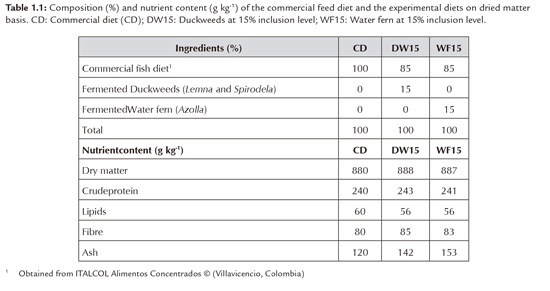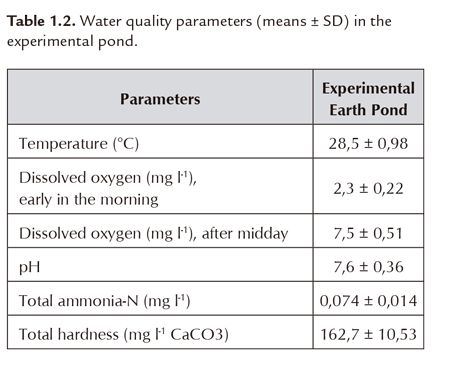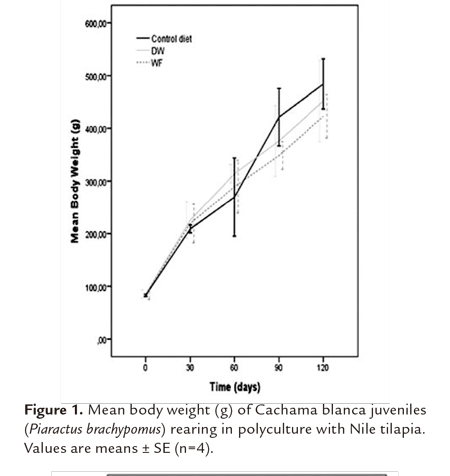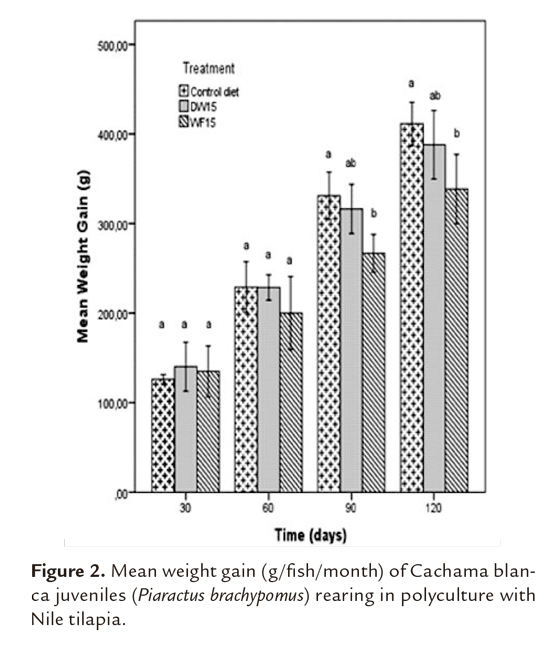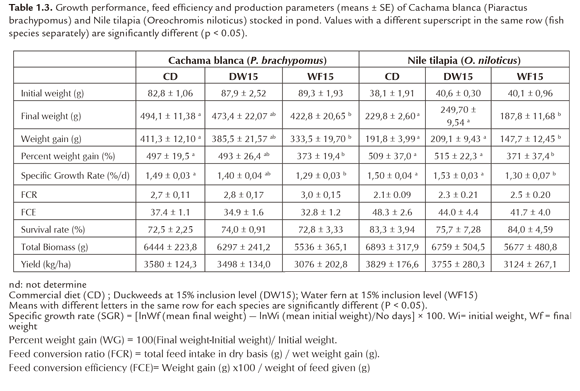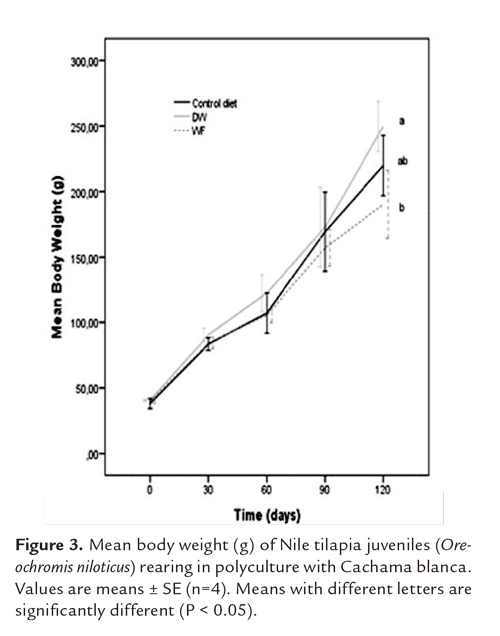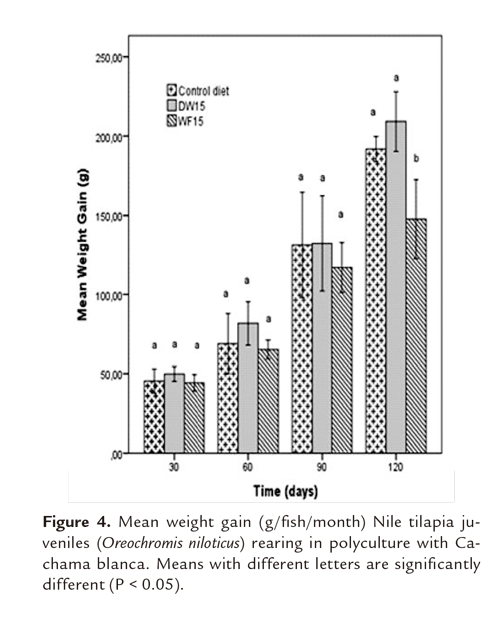Services on Demand
Journal
Article
Indicators
-
 Cited by SciELO
Cited by SciELO -
 Access statistics
Access statistics
Related links
-
 Cited by Google
Cited by Google -
 Similars in
SciELO
Similars in
SciELO -
 Similars in Google
Similars in Google
Share
ORINOQUIA
On-line version ISSN 0121-3709
Orinoquia vol.18 supl.1 Meta Dec. 2014
ARTÍCULO ORIGINAL/ORIGINAL ARTICLE
On-farm evaluation of Cachama blanca and Nile tilapia fed fermented aquatic plants in a polyculture
Evaluación del policultivo de Cachama blanca y la Tilapia del Nilo alimentada con plantas acuáticas fermentadas
Avaliação da policultura da Pirapitinga e Tilápia do Nilo alimentadas com plantas aquáticas fermentadas
Yorcelis Cruz-Velásquez 1
Claudia Kijora 2
Wensy Vergara-Hernández 3
Carsten Schulz4
1Ing., PhD, Thaer-Institute of Agricultural and Horticultural Sciences, Humboldt Universität zu Berlin, Germany. Instituto de Investigaciones Tropicales de la Universidad Del Magdalena, Santa Marta, Colombia
2PhD (Dr. habil), Thaer-Institute of Agricultural and Horticultural Sciences, Humboldt Universität zu Berlin, Germany
3 Ing. MSc, Instituto de Investigaciones Tropicales de la Universidad Del Magdalena. Santa Marta, Colombia
4 Prof. Dr., GMA - Gesellschaft für Marine Aquakultur mbH, Büsum, Germany and Institute for Animal Husbandry at the Christian-Albrechts-University of Kiel, Germany
Email: yorcelis.cruz@hu-berlin.de
Recibido: octubre 30 de 2014. Aceptado: noviembre 28 de 2014
Abstract
Juveniles of Cachama blanca and Nile tilapia averaging 86.7 g and 39.6 g, respectively, were co-stocked in 12 experimental units (18m2 in area) at a total density of three fish m-2.The species mixture consisted of 25% Cachama blanca and 75% tilapia. The fish were fed with a commercial aquafeed (24% crude protein) as control diet. Fermented duckweeds (DW), Lemna minor and Spirodela polyrhiza, and fermented water fern (WF), Azolla filiculoides, at 15% substitution level of the commercial aqua feed were offered as experimental diets for a total of three treatments with four replicates per treatment. The experiment was carried out during a period of 120 days of rearing. Growth performance and productive parameters were evaluated. Results on Cachama blanca showed that no significant differences were found for FCR (from 2.7 to 3.0), total Biomass (5536 to 6444 g) and yield (from 3076 to 3580 kg/ha) among treatments. Mean final weight (from 423 to 494 g), weight gain and specific growth ratio (SGR) were higher for Cachama blanca fed on control and DW diets than for those fed on WF diets. Similar results were observed for Nile tilapia. Mean final weight, weight gain and SGR of Nile tilapia fed on DW do not differed significantly from the control diet, but for those fed on WF, which performance was significantly lower. Yield for Nile tilapia varied from 3124 to 3829 kg ha-1 and did not differ between the treatments. Average FCR was calculated for Nile tilapia between 2.1 and 2.5 and was better than for Cachama blanca. Results indicated that fermented duckweeds (Lemna minor and Spirodela polyrhiza) can effectively replace commercial aqua feed at a 15% level for rearing juveniles of Cachama blanca and Nile tilapia in a traditional polyculture.
Key Words: Cachama, duckweeds, fermentation, polyculture, tilapia, water fern.
Resumen
Juveniles de Cachama blanca y Tilapia del Nilo con un promedio de 86.7 y 39.6 g, respectivamente, fueron cultivados en 12 unidades experimentales (18m2) con una densidad total de tres pecesm2. La mezcla de especies consistió en 25% Cachama blanca y el 75% Tilapia. Los peces fueron alimentados con un pienso comercial (proteína bruta 24%) como dieta de control. La lenteja de agua fermentada (Duckweeds: DW), (Lemna minor y Spirodela polyrhiza), y la Azolla fermentada (Water fern: WF), (Azolla filiculoides), fueron ofrecidas como dietas experimentales al 15% de nivel de sustitución para un total de tres tratamientos con cuatro repeticiones por tratamiento. El experimento se llevó a cabo en un período de 120 días. El crecimiento y los parámetros productivos fueron evaluados. Los resultados de Cachama blanca mostraron que no se encontraron diferencias significativas para el FCR (2,7-3,0), la biomasa total (desde 5536 hasta 6444 g) y el rendimiento (3076 a 3580 kg/ha) entre los tratamientos. El peso final (423-494 g), la ganancia de peso y la tasa de crecimiento específico (SGR) fueron mayores para la Cachama blanca alimentada con la dieta control y la dieta DW que para aquellos alimentados con la dieta WF. Resultados similares fueron observados para la Tilapia del Nilo. El peso final medio, la ganancia de peso y la tasa de crecimiento específica (SGR) de la Tilapia del Nilo alimentados con la dieta DW no diferían de manera significativa de la dieta control, pero sí de los peces alimentados con la dieta WF, lo cuales mostraron un desarrollo significativamente menor. El rendimiento de la Tilapia del Nilo varió de 3124 a 3829 kg/ha y no hubo diferencias entre los tratamientos. El FCR promedio calculado para la Tilapia del Nilo fue entre 2.1 y 2.5 y resultó mejor que para la Cachama blanca. Los resultados indicaron que la lenteja de agua fermentada (Lemna minor y Spirodela polyrhiza) puede reemplazar efectivamente hasta un 15% del alimento comercial en un policultivo tradicional de Tilapia del Nilo y Cachama blanca.
Palabras clave: Cachama, lenteja de agua, fermentación, policultivo, Tilapia, Azolla.
Resumo
Juvenis de Pirapitinga e Tilápia do Nilo com uma média de 86.7 e 39.6 g, respectivamente, foram cultivadas em 12 unidades experimentais (18m2) com uma densidade global de três peixesm2. A mistura de espécies consistiu de 25% de Pirapitinga e 75% Tilápia do Nilo. Os peixes foram alimentados com uma ração comercial (24% de proteína bruta) como dieta de controle. As lentilhas da água fermentada (duckweeds: DW), Lemna minor e Spirodela polyrhiza, e Azolla fermentada (water fern: WF), Azolla filiculoides, foram oferecidas como dietas experimentais a 15% de nível de substituição para um total três tratamentos com quatro repetições por tratamento. O experimento foi realizado durante um período de 120 dias. Foram avaliados os parâmetros de crescimento e de produção. Resultados para a Pirapitinga não mostraram diferenças significativas para o FCR (2.7-3.0), a biomassa total (5536-6444 g) e rendimento (3.076-3.580 kg/ha) entre os tratamentos. O peso final (423-494 g), ganho de peso e taxa de crescimento específico (TCE) foram maiores para a Pirapitinga alimentada com a dieta controle e dieta DW do que para aqueles alimentados com a dieta WF. Resultados similares foram observados para a Tilápia do Nilo. O peso médio final, ganho de peso e taxa de crescimento específico (TCE) da Tilápia do Nilo alimentada com a dieta DW não diferiu significativamente da dieta controle, mas, sim, daqueles peixes alimentados com dieta WF, que mostraram significativamente menos desenvolvimento. O desempenho da Tilápia do Nilo variou de 3124-3829 kg/ha e não houve diferenças entre os tratamentos. A FCR média calculada para a Tilápia do Nilo foi dentre 2.1 e 2.5 e foi melhor do que para a Pirapitinga. Os resultados indicaram que a lentilha de água fermentada (Lemna minor e Spirodela polyrhiza) pode efetivamente substituir até 15% do alimento comercial em uma policultura tradicional de Tilápia do Nilo e Pirapitinga.
Palavras-chave: Pirapitinga, lentilha d’água, fermentação, policultura, Tilápia, Azolla.
Introduction
According to FAO (2012) the major aquaculture producing countries of Latin America in 2010 were Chile (701.062 tonnes), Brazil (479.399 tonnes), Ecuador (271.919 tonnes), Mexico (126.240 tonnes), Peru (89.021 tonnes) and Colombia (80.367 tonnes). Florez-Nava (2007) reported that the aquaculture sector in the region is mainly based on tropical and subtropical species (excepting Chile) and export-oriented, therefore it is highly depending on fish feed or pelleted diets. Fishmeal constitutes the main raw material for fish feed. However, due to the high demand and cost of fishmeal, its substitution with locally available vegetable proteins has become prevalent in the region, mainly in the rural sector.
A variety of aquatic plants are widely available thought the whole year in several water bodies in the tropics. Some of them have a good nutritional composition and are already used in the diet of monogastric animals. However, many of them remain still underused. The Duckweeds (Lemna minor and Spirodela polyrhiza) as well as the Water fern (Azolla filiculoides) possess high protein content (15.7% to 26.4% CP) and have been tested for acceptability and digestibility in previous experiments with tropical fish species (Cruz et al., 2011b).
Thus, their use seems be suitable for replacement of fishmeal in the diet of omnivorous-herbivorous fish.
Among the commonly farming fish cultivated in Latin America the characids are the most important group of native fish. The Tambaqui (Colossomama cropomum), the Pacu (Piaractus mesopotamicus) and the Cachama blanca (Piaractus brachypomus) are widely cultured in their native river basins. The Tambaqui and Pacu have also been introduced to other countries within and outside the region (FAO, 2005), whereas Cachama blanca has become economically the most important fish in Colombia (Espinal et al., 2005).
Considering that cultivation of different fish species in the same pond makes feasible the optimum utilization of the available resources in the aquatic environment, the polyculture of tilapia, the most common tropical farming fish, and a native species as the Cachama blanca (Piaractus brachypomus) seems to be a good alternative to increase the productivity of the rural tropical aquaculture. Moreover, the integration of these species in a polyculture is highly according to the recent efforts dedicated to the utilization of native species in South America.
The Nile tilapia (Oreochromis niloticus) is an omnivorous and filtrating fish that feeds plant material, phytoplankton and benthos by preference. Cachama blanca (Piaractus brachypomus) feeds primarily on plant material. Consequently, the provision of primary food through fertilizing the ponds and through use of aquatic plants that require minimal effort to be cultivated has the potential to lead to economic feasibility for small-scale farmers. These species, Tilapia and Cachama blanca, are considered a very effective food fish.
Thus, the objective of this study was to evaluate the effect of replacing 15% commercial fish feed (24% crude protein) with fermenting locally available aquatic plants; duckweeds Lemna minor and Spirodela polyrhiza (DW15) and the water fern Azolla filiculoides (WF15), on the growth performance and productive parameters of two valuable fish species, Tilapia and Cachama blanca, in a traditional polyculture.
Material and methods
This study was conducted from June to October 2009 using the facilities of Instituto de InvestigacionesTropicales (Intropic) at the University of Magdalena in Colombia (longitude 74º 07’ and 74º 12’ W - latitude 11º 11’ and 11º 15’ N). The experiment was carried out for 120 days. Three treatment diets were tested each with four replicates.
Culture system and stocking of fish
The fish used in this study, Nile tilapia (Oreochromis niloticus) and Cachama blanca (Piaractus brachypomus), were obtained from local suppliers in Villavicencio (Colombia) and remained in the Aquaculture Laboratory of the University of Magdalena until all juveniles of Nile tilapia and the Cachama blanca achieved a weight averaging 39.6 ± 2.52 g and 86.7 ± 4.5 g (mean ± SD), respectively.
Juveniles were cultivated in one earth pond divided into 12 experimental units, each one with 18m2 in area and 0.9 m in depth. The stocking ratio of fish was distributed to the proportion 75% Nile tilapia and 25% Cachama blanca with a total density of three fish per m-2. Before stocking of the culture pond a careful selection of only male Nile tilapia was determined through manual sexing. The pond was prepared prior through draining and sun drying. Afterwards, it was fertilized and then filled with water until the level reached 0.9 m. Fertilization consisted of 400 kg ha-1 poultry manure inserted weekly during the first month. In order to maintain the plankton population, fertilization was carried out monthly using the water transparency as a paramater (Secchi-disk). The pond was refilled with water once per week to replenish infiltration and evaporation.
Feed and feeding regime
As a control diet, fish were fed on a 24% protein commercial aqua feed. The experimental diets were composed of 85% commercial aqua feed and 15% of each of the tested ingredients; the duckweeds Spirodela polyrhiza and Lemna minor (DW15)and the water fern Azolla filiculoides (WF15) treated by lactic acid fermentation. The fermentation of aquatic macro-phytes was carried out as described by Cruz et al., (2011a) through the supplementation with LAB inoculants and molasses. The dietary ingredients were ground, mixed homogeneously and dry pelleted to 4 mm diameter. Diets were offered at 4% of mean fish biomass 6 days per week and at two times per day (10:00 and 17:00). During the trial, the feeding rate was reduced gradually to 2% of biomass. The analysis of the nutritional composition for the diets was performed according to AOAC (2005) and is shown in Table 1.1.
Growth and yield
Fish were weighed and measured monthly for growth determination and feed adjustment. At least 10% of each species of the fish population were collected from each experimental unit. The total fish weight was calculated using the mean weight of the sampled fish multiplied by the total number of fish stocked at the beginning of the trial. After 120 days fish were harvested, the data was collected for total weight, size, and number of fish and the survival rate, feed conversion and yield were determined.
Growth, yield, feed utilization and survival parameters measured or calculated were the following: initial (iW) and final (fW) mean body weight (g), total biomass (g), specific growth rate (SGR) = [((lnfW — lniW)/120 days) × 100]; weight gain (WG) = [ fW-iW]; per cent weight gain % (PWG)= 100 x (fW-iW)/iW; feed conversion ratio (FCR) = [total feed intake in dry basis (g)/wet weight gain (g)]; feed conversion efficiency % (FCE)= Weight gain (g) x100 / weight of feed given; survival rate (SR) = [(total number of fish harvested x 100)/total number of fish stocked] and yield (Y) = [total number of fish stocked x SR x WG (kg)/area of the ponds (ha)].
Water quality
The water quality parameters were evaluated daily during the 120 day trial. Dissolved oxygen and water temperatures were measured early in the morning and in the afternoon using an oxygen sensor (Hanna HI9146). The pH (Hanna hand-pH-meter) was also measured. Total ammonia-N was measured weekly using a colorimetric method. Total hardness was measured every 15 days using a colorimetric test.
Statistical analysis
Data are presented as treatment means ± SE (standard error). Results of the three groups were analysed using one-way analysis of variance (ANOVA). Means of statistically different variables were compared by Tukey’s test and LSD test (P < 0.05). Homogeneity of the variances was determined by Levene’s Test (P < 0.05) and by Dunnett`s T3 (P < 0.05) for homogeneous and inhomogeneous variances, respectively. All data were statistically analysed using SPSS (version 19) software package for Windows.
Results
The composition of the experimental diets is given in Table 1.1. In the diet composition a significant variation can be observed in the ash content. Control diet (CD) presents an ash content of 120 g Kg-1, while diets including fermented water plants show a higher level of ash. In the case of DW15, ash content is 18% higher compared to the control. This difference is even more drastic for WF15 with 28% higher ash content compared with the control. Water quality parameters of the experimental units are presented in Table 1.2. Temperature and pH were constant and presented an average of 28.5 °C and 7.6, respectively. The minimal values of the dissolved oxygen (DO) were registered in the early morning ranging from 2.0 to 2.6 mg l-1. During the day DO varied into optimal ranges from 6.7 to 8.3 mg l-1. The values of total ammonia-N did not present high variations, due to the fact that a constant refill was maintained.
Growth performance, feed efficiency and production parameters of Cachama blanca and Nile tilapia in polyculture are shown in Table 1.3. Final mean weight of Cachama blanca ranged from 422.8 to 494.1 g, percent of weight gain of Cachama blanca varied from 373 to 497% and SGR from 1.29 to 1.49 % day-1, indicating in all cases significant differences (P < 0.05) among control and WF15 treatment. Weight gain of Cachama blanca among treatments was similar during the first 60 days (Figure 2). Afterwards, Cachama blanca fed on control and DW15 diets gained weight faster than fish fed on WF15. This result in weight gain of Cachama blanca did not differ significantly between fish fed on control diet and DW15 (Figure 1), but did between control and WF15 (Figure 2). FCR varied from 2.7 to 3.0 and no differences (P > 0.05) were found. Survival of Cacha mablanca in the polyculture was over 72%. Total biomass and yield of Cachama blanca was also expected to be significantly affected by treatments, however no significant variations were found. Although the differences were not significant, probably due to variability between replicates, they may be considered relevant. Yield of Cachama blanca fed on WF15 was about 14% lower than for control and DW15.
Similar results were obtained for Nile tilapia. Final mean weight ranged from 187.8 to 249.7 g, percent of weight gain varied from 371 to 509 %, and SGR varied from 1.3 to 1.5 % day-1 indicating significant differences (P < 0.05) among treatments. Weight gain of Nile tilapia during treatments was similar during the first 90 days (Figure 4). Afterwards, Nile tilapia fed on WF15 showed a significantly lower growth performance (P > 0.05). Nile tilapia fed on DW15 displayed a trend of higher weight gain than the control diet. Growth parameters of Nile tilapia fed on DW15 and on the control diet did not present differences, but fish fed on WF15 showed a significantly lower growth (Figure 3 and 4). FCR varied from 2.1 to 2.5 and no statistically differences (P > 0.05) were found. In the case of Nile tilapia survival was over 75% and did not vary (P >0.05) among treatments. Total biomass and yield did not vary significantly. However, yield of Nile tilapia fed on WF15 was around 18% lower than for control and DW15.
Calculated FCR and FCE for the polyculture system presented significant differences between control (2.4 and 41.6 %) and WF15 (2.8 and 36.0 %) treatment.
Results in percentage of weight gain, SGR, survival rate, total biomass and yield for both species were comparable. Results showed that Cachama blanca and Nile tilapia grow well when fed on commercial diets replaced at 15% by DW, whereas the use of WF at the same inclusion level degraded growth performance of both species.
Discussion
Climate conditions during the experimental period were marked for unusually higher rainfalls due to the climatic phenomena La Niña which occurs around the Pacific coast and leads to dramatic weather conditions in whole Colombia. Although climate affects water parameters, no variations were noticed in the water quality factors among the different treatments as all experimental units were placed in the same pond, adjacent to one another and receiving water from the same source. Water quality parameters in the pond ranged within the acceptable requirements reported for cultured fish species (Boyd, 1982). Temperature and pH were found to be the more consistent parameters during the course of the trial. Oxygen was marked lower in the early morning, but it did not affect feed consumption when feed was offered around 10 am.
A comparison between the two supplemented water plants shows that their inclusion into the diets affected the utilization of nutrients by Cachama blanca and Nile tilapia. Growth was significantly reduced when WF was included at 15%. Rather than from the beginning of the experimental period, it was determined that growth was affected only after a period of time which suggests a progressive accumulation of one or more elements with an anti-nutritional effect. A potential explanation was the high ash content in WF15 diet, Cruz et al. (2011) reporting that mineral concentration should be considered before the inclusion of water fern Azolla filiculoides into fish diets due to its high content of zinc, copper and chromium. For confirmation of this result further study on carcass composition must be carried out. Otherwise, fish grew well when duckweeds were included at 15%, for Cachama blanca fed on DW15 there were no significant differences with the control and for Nile tilapia fed on DW15 growth performance was better than in the control, but no significant.
This result was observed in a previous experiment with Nile tilapia. According to Cruz Velázquez et al. (2015) Nile tilapia tolerates inclusion of DW up to 25% in formulated diets (35% CP) with low fish meal content, while for the same diet the maximum level of WF was 15% without an impact on growth performance, feed conversion and animal welfare Final weight gain of Cachama blanca was two-fold higher than for Nile tilapia. However, percentage of weight gain was very close and comparable between the two species. In fact, in the trend, the percentage of weight gain was higher for Nile tilapia. It was not expected. A relative restricted growth and feed utilization by Nile tilapia comparable to Cachama blanca was assumed due to the early breeding of female Nile tilapia mistakenly included in the population, which occurred despite manual sexing being carried out. Otherwise, the comparable growth percentage of Nile tilapia could be due to its feeding on plankton from natural pond biota, in contrast to Cachama blanca which is a non-filter feeder fish that is unable to take advantage of the plankton. Therefore, Nile tilapia could compensate its energy requirements. Green et al. (1994) reported in their study that Tilapia grows adequately in fertilized ponds with only natural productivity.
Also the extensively stocked ponds (3 fish m-2) could have a positive impact on the recovery of the energy balance for Nile tilapia, especially during the last phase of the experimental period. Fish growth is highly dependent on stocking density (Jha and Barat, 2005). An increasing density is accompanied by an increase on stress, feed competition and therefore energy requirements which lead to a reduced growth and feed utilization (Pickering, 1993, Abou Y. et al., 2007).
Tilapia reproduction occurred commonly as a result of imperfect sex reversal. This problem is commonly avoided by the careful selection of only males prior to the stocking of the culture pond, as done in this study and alternatively predatory fish are carefully utilized to thin out the Tilapia (Green et al, 1994). It had been assumed that females of Nile tilapia used large percentage of the ingested energy for the physiological changes associated with sexual maturation affecting the maximum attainable size of the original stock in grow out. Therefore small fish were harvested monthly in order to maintain the equilibrium of the culture.
The SGR values obtained for Cachama blanca in this study was comparable to those reported by Vásquez et al., (2012) in their study on Cachama blanca in cages (SGR from 1.38 to 1.46 % day-1) and in ponds (1.33 to 1.70% day-1) offering formulated diets at 26, 30 and 34% of digestible protein level. In their study, Vásquez et al., (2012) obtained the best SGR from diets with the maximal protein level, whereas in the present study protein level in all diets was 24%. These results confirm that in captivity Cachama blanca accepted very well artificial diets even with low levels of protein as reported by Vasquez-Torres (2005). In another study, Tafur-Gonzales et al., (2009) also presented SGR (1.75 % day-1) and weight gain (449.7 g) values for P. brachypomus raised in polyculture with the planctivore cichlid Chaetobranchus semifasciatus. These results, as well as ours, confirm the significant growth performance of Cachama blanca in polyculture. This has also been reported by Ascón et al., (2003) in their study on polyculture of Cachama negra (Colossoma macropomum) and Boquichico (Prochilodus nigricans). Several authors reported that P. brachypomus and Colossoma macropomum normally reach a weight from 300 to 600 g between 4 and 6 months of culture (CamposBaca and Kohler, 2005; Lochmann et al., 2009), which is in accordance with the results obtained in this study.
The FCR for Cachama blanca was higher than those reported in the literature for the polyculture of this species. It is possible that the overpopulation of Nile tilapia also affected the feed consumption of Cachama blanca. In general there are limited number of reports in the literature regarding the culture of Cachama blanca in earthen ponds and its productive parameters. Tafur-Gonzales et al., (2009) reported a FCR of 1.05, which is very good, but in their study, total density of fish was also much lower (1 fish m-2). Abimorad et al., (2009) reported FCR from 1.35 to 1.85 in diets for Pacú (Piaractus mesopotamicus) reared in cages and fed on diets based on plant ingredients and supplemented with lysine and methionine, whereas the basal diet without dietary supplementation showed a FCR of 2.15, which is closest to the results of this study. Vásquez and Arias (2012) also reported FCR of 1.0 for Cachama blanca, when it was fed on a semi purified diet containing three different sources of carbohydrates and lipids at 32% protein level.
Yield parameters were comparable among treatments and they were similar to those reported by other authors for the polyculture of Nile tilapia and characids as Cachama blanca. Teichert-Coddington (1996) reported a comparable mean production from 2537 to 5265 kg/ha in his study on polyculture of Nile tilapia and Cachama negra (Colossoma macropomum) in Central America. Tafur Gonsalez et al., (2009) also reported similar mean production (3825 Kg/ha/year) for P. brachypomus in polyculture with Cachama negra (Colossoma macropomum) and the cichlid Chaetobranchus semifasciatus, a cichlid herbivore, and native of the Amazon. Total biomass suggests that polyculture of Cachama blanca and Nile tilapia could result in two harvests per year with yields of aprox. 7000 and 7500 kg/ha/year, respectively, offering commercial feed (24% CP) supplemented with fermented DW at 15% and maintaining a constant production of plankton in the pond.
Results show that these two fish species are very well suited for production in extensive polyculture systems. In these systems, commercial diets with low protein content provide both good biomass and yields. The substitution with duckweeds appeared to have no negative affect on all the production parameters. It is therefore highly recommended as cheaper feed component in rural production. Water fern, which is easier to harvest, could be used for a limited time (max. 60 days) in the culture without causing a negative effect.
References
Abimorad EG, Favero GC, Castellani D, Garcia F, Carneiro DJ. Dietary supplementation of lysine and/or methionine on performance, nitrogen retention and excretion in pacu Piaractus mesopotamicus reared in cages. Aquaculture. 2009; 295: 266270. [ Links ]
Abou Y, Fiogbe ED, Micha JC. Stocking density improve yield and profitability of Nile tilapia. Aquac Res. 2007;38:595-604. [ Links ]
AOAC International. 2005. Official methods of analysis of AOAC International. 18th edition. Gaithersburg, MD, USA. [ Links ]
Ascón G, Guerra H, Iberico L. 2003. Policultivo de Gamitana, Colossoma macropomum más Boquichico, Prochilodus nigricans durante 24 meses, en tres fases consecutivas de cultivo. Technical Report. Programa de Ecosistemas Acuáticos, Instituto de Investigaciones de la Amazonía Peruana (IIAP). 16p. [ Links ]
Boyd CE. 1982. Water Quality Management for Pond Fish Culture. Elsevier Scientific Publishing, New York, USA. [ Links ]
Campos-Baca L, Kohler C. Aquaculture of Colossoma macropomum and related species in Latin America. Am Fish Soc Symp. 2005;46:451-561. [ Links ]
Cruz Velásquez Y, Kijora C, Wuertz S and Schulz C. Effect of fermented aquatic macrophytes supplementation on growth performance, feed efficiency and digestibility of Nile Tilapia (Oreochromis niloticus) juveniles fed low fishmeal diets. Livest Res Rural Dev. 2015;27:177. [ Links ]
Cruz Y, Kijora C, Wedler E, Danier J and Schulz C. Fermentation properties and nutritional quality of selected aquatic macrophytes as alternative fish feed in rural areas of the Neotropics. Livest Res Rural Dev. 2011;23:239. [ Links ]
Cruz Y, Kijora C, Torres-Vásquez W, Schulz C. 2011.Dry matter, protein and energy digestibility of selected aquatic macrophytes treated by sun drying and lactic-acid fermentation for the Amazonian fish Piaractusbrachypomus (Cuvier, 1818). In: Tropentag Proceedings 2011. Pp382 URL: http:// www.tropentag.de/2011/abstracts/links/Cruz_ AHN0PuE8.php [ Links ]
Espinal C, Martínez H, Gónzalez F. 2005. La cadena piscícola en Colombia: Una mirada global de su estructura y dinámica 1991-2005. MADR, Observatorio Agrocadenas de Colombia. Documento de Trabajo. Bogotá, 46 p. [ Links ]
FAO. 2012. The State of World Fisheries and Aquaculture 2012. Food and Agricultural Organization of the United Nations. URL: http://www.fao.org/docrep/016/i2727e/i2727e.pdf [ Links ]
Flores-Nava A. 2007. Feeds and fertilizers for sustainable aquaculture development: a regional review for Latin America. In: Hasan, M. R., Hecht, T. De Silva, S. S. and Tacon, A. G. J. (Eds.). Study and analysis of feeds and fertilizers for sustainable aquaculture development.FAO Fisheries Technical Paper.No. 497. Rome, FAO, pp 49-75. [ Links ]
Green BW, Teichert-Coddington DR, Hanson TR. 1994. Development of semi-intensive aquaculture technologies in Honduras: Summary of freshwater aquacultural research conducted from 1983 to 1992. Res. Dev. Ser. No.39, International Center for Aquaculture and Aquatic Environments, Auburn University, AL, 48 pp. [ Links ]
Jha P, Barat S. The effect of stocking density on growth, survival rate and number of marketable fish produced of Koi carp, Cyprinuscarpiovr. Koi in concrete tanks. J. Appl Aquacult. 2005;17:84102. [ Links ]
Lochmann R, Chen R, Chu-Koo F, Camargo W, Kohler C, Kasper C. Effect of carbohydrate-rich alternative feedstuffs on growth, survival, body composition, hematology, and nonspecific immune response of black pacu, Colossomamacropomum, and red pacu, Piaractus brachypomus. J World Aquac Soc. 2009;40(1):33-44. [ Links ]
Pickering AD, Growth and stress in fish production. Aquaculture. 1993;111:51-63. [ Links ]
Tafur Gonzales J, Alcántara Bocanegra F, Del Águila Pizarro M, Cubas Guerra R, Mori-Pinedo L, Chu-Koo F. Paco Piaractus brachypomus y Gamitana Colossoma macropomum criados en policultivo con el Bujurqui-Tucunaré, Chaetobranchus semifasciatus (Cichlidae). Folia Amazónica. 2009;18(1/2):97-104. [ Links ]
Teichert-Coddington DR. Effect of stocking ration on semi-intensive polyculture of Colossomamacropomum and Oreochromisniloticus in Honduras, Central America. Aquaculture. 1996;143(3/4): 291-302. [ Links ]
Vásquez-Torres W. 2005. A pirapitinga, reprodução e cultivo. In: Baldisserotto, B. and Gomes, L. de C. (Eds.). Especies nativas para piscicultura no Brasil, Editora da UfSM, Santa Maria, Brasil. pp 203-223. [ Links ]
Vásquez-Torres W, Arias-Castellanos JA. Effect of dietary carbohydrates and lipids on growth in cachama (Piaractusbrachypomus). Aquacult Res. 2013;44(11):1768-1776. [ Links ]
Vásquez-Torres W, Hernández-Arévalo G, Gutiérrez-Espinosa M, Yossa M. Effects of dietary protein level on growth and serum parameters in cachama (Piaractus brachypomus). Rev Colomb Cienc Pec. 2012;25:450-461. [ Links ]













